W3 Spatial Vision: Lines and Texture
1/26
There's no tags or description
Looks like no tags are added yet.
Name | Mastery | Learn | Test | Matching | Spaced |
|---|
No study sessions yet.
27 Terms
New Concepts
area V1 of visual cortex
detecting oriented lines and edges (w simple + complex cells)
inhibition over space (via hyper-complex cells)
inhibition over space in terms of:
texture segmentation
simultaneous tilt illusion
simultaneous size illusion
inhibition over times in terms of:
tilt after-effect
size after-effect
Oriented edges and bars: Cortex area V1
Classical view - Hubel and Wiesel (1950s)#
won Nobel prize
cat - 1962, monkey - 1968
Simple cells = orientation sensitive, off + on regions
Complex cells = orientation sensitive, prefers thin lines, no off region
Hypercomplex = same as complex cells, but prefer short lines
Cortex area V1: Simple Cells
simple cells have receptive fields
structured on / off regions
different orientations and sizes
because of these diff orientations = allows V1 cells to detect stimuli at diff orientations + sized
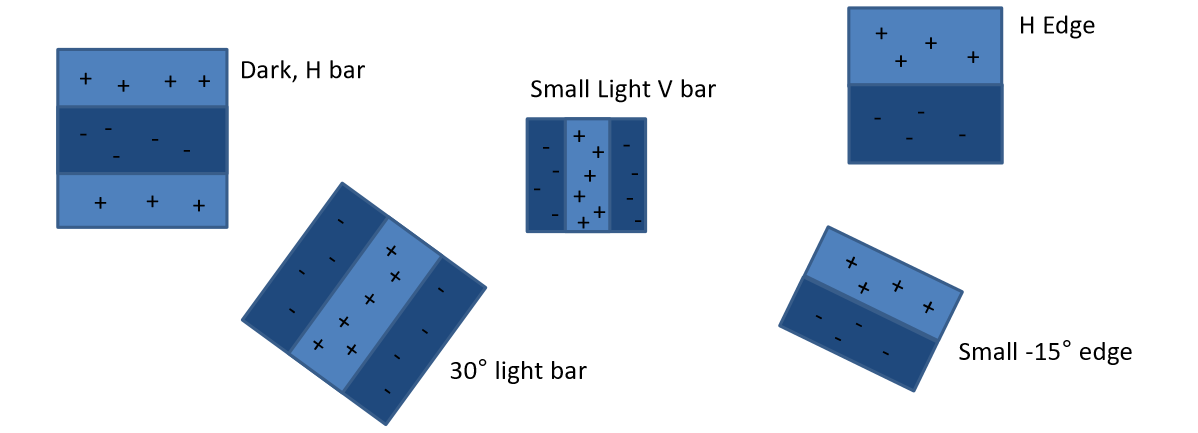
Orientation selectivity in simple cells
whichever angle you present light to a cell in retina/LGN = always excites the same art of the receptive field
in simple cell (V1) = the cell will fire maximally when the stimulus excited only the ‘on’ part of the receptive field
highest red dot is when light is vertical through on section
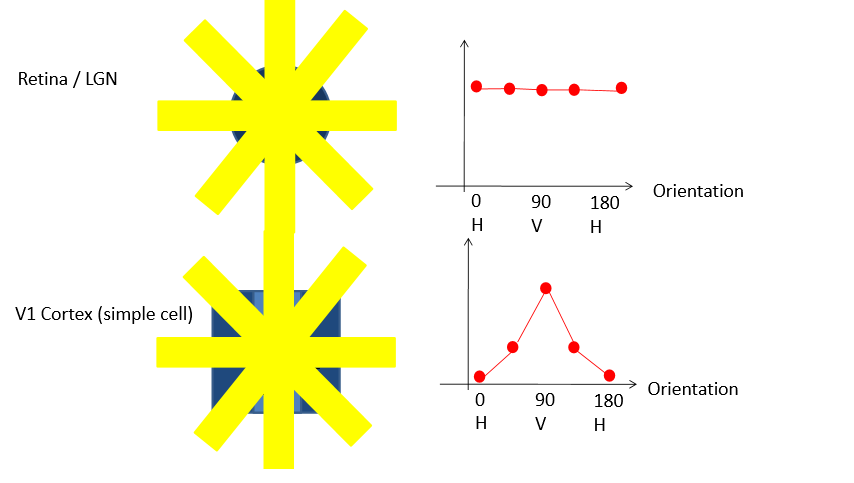
Position sensitivity in simple cells
V1 simple cells can detect the position of an object in space
because as the light moves into the ‘on’ part of the cell = excites it maximally
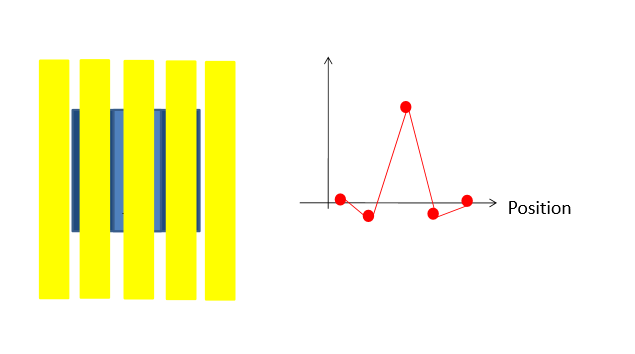
Size sensitivity (spatial frequency)
width + spatial frequency
wide object = bc it overlaps on/off regions = cancels out activity
as stimulus becomes more narrow / spatial frequency increases = overlaps with on part of receptive field = fires maximally
as it becomes more narrow = part of stimulus overlaps on/off regions = decreases firing of the cell

Making a simple cell
simple cells constructed by combining the output of many concentric receptive fields from the LGN
imagine the ‘on’ sections of a concentric receptive field sending their output to the on/excitatory part of the V1 simple cell
and all the inhibitory parts of the concentric LGN cells = sending output to inhibitory part of the V1 simple cell
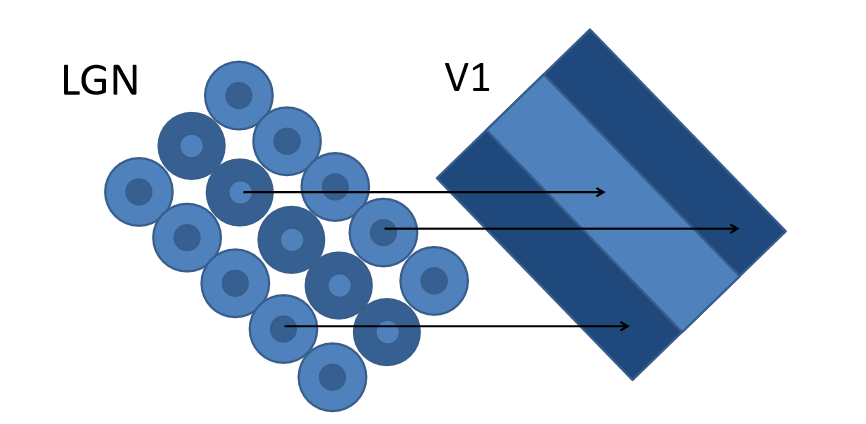
Summary: Simple cells
Orientation selective
some position selective
some size selective
Separate on / off regions
Length summation = strong response to long bar / little response to short bar
= SO, simple cells in V1 respond to edges at particular locations + orientations within the visual field
Cortex area V1: complex cells
they are more complex cells in V1
high resting output (no stimulus = more activity)
receptive fields were defined but unstructured = no on/off receptive field
also orientation sensitive
also spatial frequency sensitive
not sensitive to line position within the recepetive field
more for abstract objects
Making a complex cell
classic view = complex cells are connected to many simple cells by an OR functions
a stimulus is detected by any of these simple cells = makes the complex cells fire
complex cells represent a more abstract type of visual info - partially independent of location within the visual field
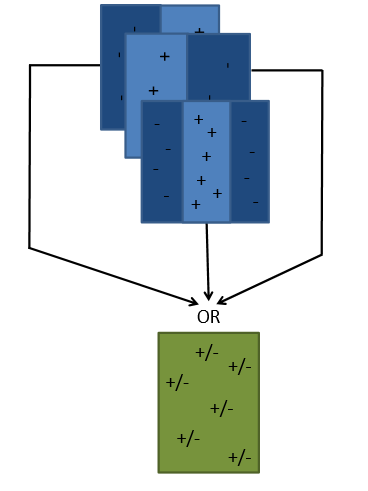
Complex cells
orientation selective
some size selective
NO separate on / off regions
not position selective
length summation
Hyper-complex cells
AKA end-stopping cells (because they can detect the length of a stimulus/object)
they are like complex cells
but they are sensitive to line length + orientation
cells turned off by stimulus outside its ‘classical’ receptive field
receptive field is organised like = the r field has two inhibitory cells either side = can turn the cell off when stimulus gets too long (end-stopping)
Hyper-complex cells: how might inhibition work?
made of 3 complex cells
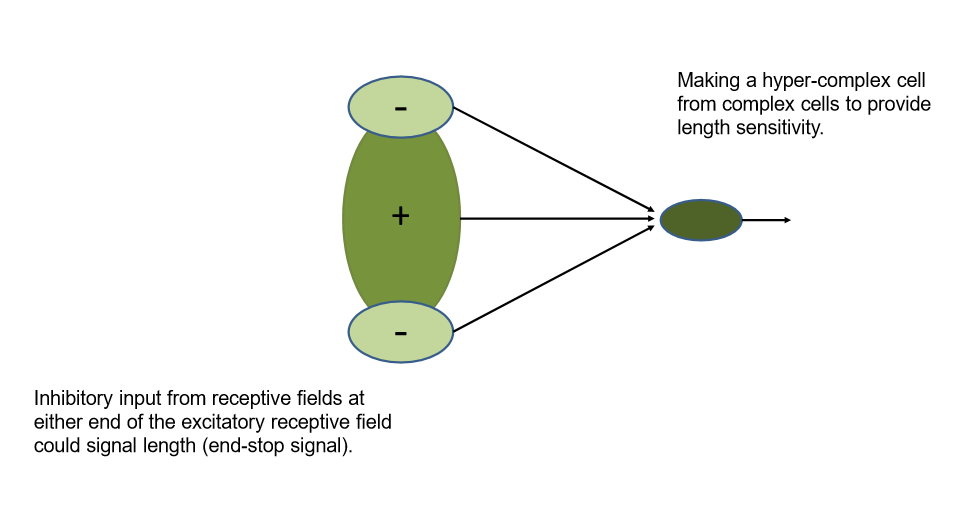
Length sensitivity
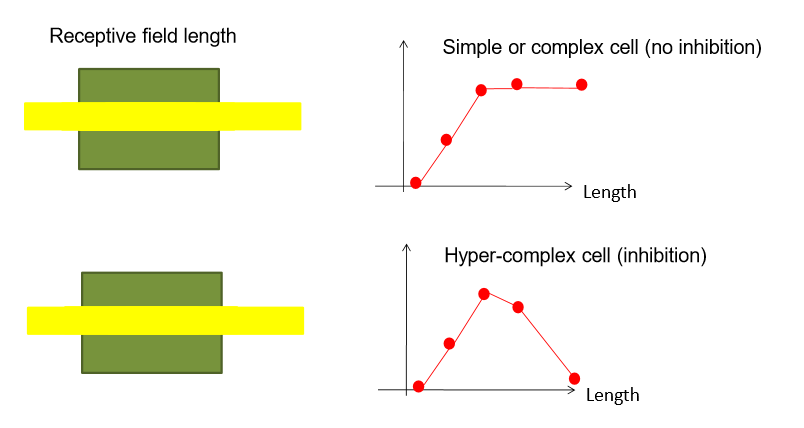
Texture segmentation: what is texture?
Texture = spatial detail at a finer scale than that which the observer currently defines as the object scale (finer detail than the object itself)
Textures are defined by statistical properties rather than absolute values
if 2 textures have the same statistical properties (as far as a human is concerned) = they are the same
If 2 textures have different stat. properties = they are different + will be separable
This enables use to see edges of objects by changes in their surface markings
Great for breaking camouflage
Texture Segmentation: Texton Theory WRONG
Texton = texture atom
Pattern elements will looks different (be segmentable) if they have different numbers of textons
Broken Ls and Ts have 6 textons (2 lines, 4 line endings)
Crosses have 7 textons (2 lines, 4 endings, 1 crossing)
THIS IS WRONG bc segmentation based on line crossings and line endings is easily disrupted
Texture Segmentations: Nothdurft (1990/91)
Texture segmentation based on line crossings + endings - is more affected by visual manipulations than by orientation
E.g. random variations in size, position disrupts segmentation based on crossings + endings (but not segmentation based on orientation)
So, orientation differences and size (local contrast) may be the only real ‘textons’
Texture segmentation: Orientation contrast model (Nothdurft, 1990)
They all have 2 line endings but due to local contrast we can segment them
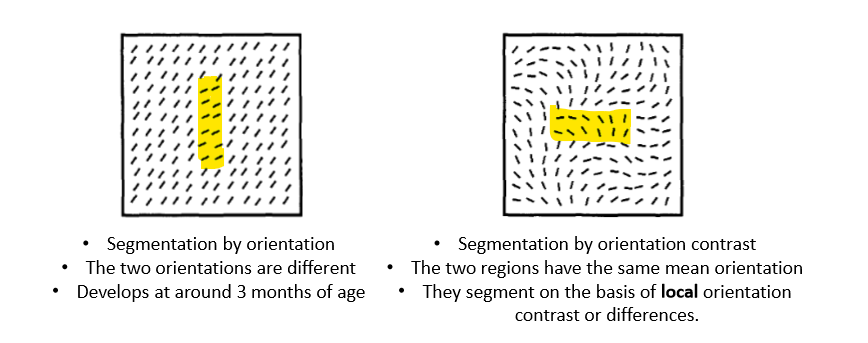
Segmentation by size contrast
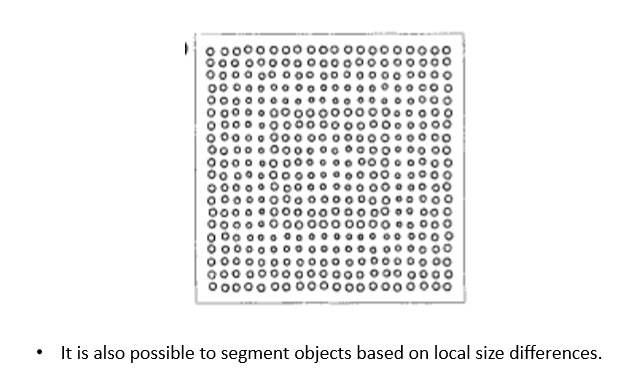
How does the brain detect orientation?
Centre surround cells
there are 2 classes of cells in V1 which are sensitive to orientation:
single opponent cell
double opponent cell
Centre surround cells for orientation
Single opponent cell:
can respond to a single orientation
can also respond when that orientation contrasts with a different one
Double opponent cell:
can respond to more than one orientation (vertical + horizontal)
also when stimuli contrast with the orientation of objects surrounding it
Single + double opponent cell
3rd bar = centre and surround are contrasting
5th bar = only double cell responds bc its horizontal stimulus
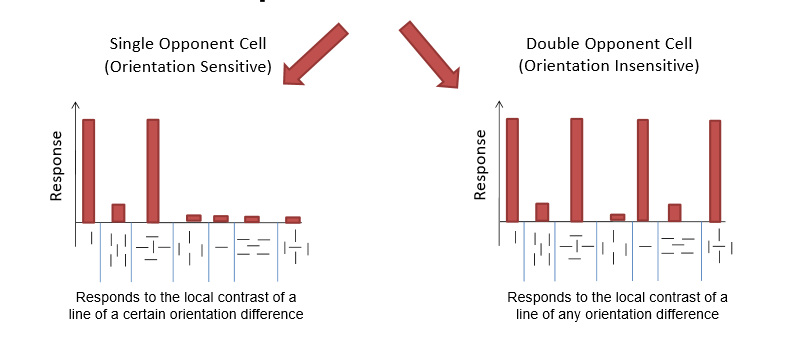
Simultaneous tilt illusion
bc of centre surround cells
tile-illusion works like simultaneous contrast but with orientation replacing luminance
the lines in periphery make the lines in centre seem tiled when they are actually straight
the receptive field for detecting orientation is creating spatial inhibition
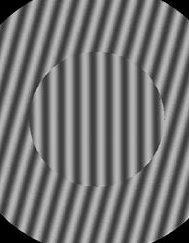
Does simultaneous contrast work for size?
Ebbinghaus illusion
peripheral part of stimulus turns of cell less = makes centre look larger
(left) peripheral circles are larger = turn off receptive field for size more = makes circle in the centre look smaller
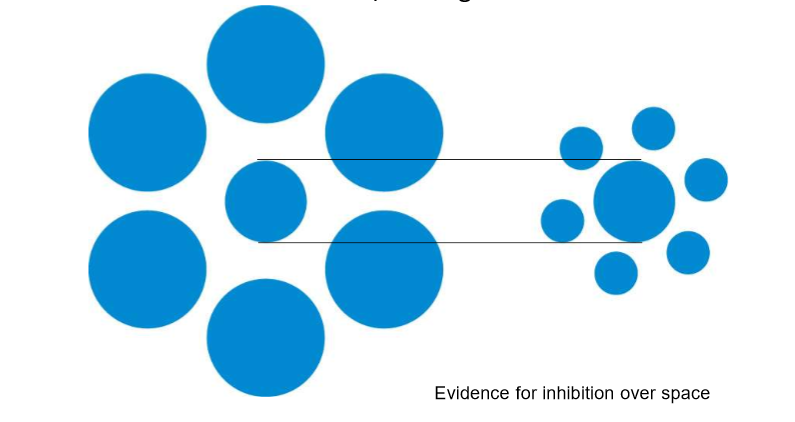
Inhibition over time: tilt after-effects
same as when you see opponent colour after looking at colour for a long time
inhibition over time in area V1 = ‘tile after-effect’
some cells inhibited after long time = the opposite orientation cells are more active
this tricks you into thinking a vertical stimulus is tilted in the opposite direction
Tilt after-effect
perceived orientation is determined by a group of cells sensitive to different orientations = the neural code
prolonged viewing (adapting) of one orientation for a long time = inhibition
the response of the active cells is decreased by adaptation / inhibition
the inhibition takes time to take effect + lasts after the stimulus goes away
the new orientation shown is not seen properly (you think its shifted to the opposite direction of the original / adapter stimulus)
Summary: Key Concepts
Cells in area V1 that respond to different orientations:
simple cells = sensitive to orientation + position
complex cells = sensitive to orientation only
hyper-complex cells = sensitive to orientation + length
hyper-complex cells may lead to perception of illusory contours in area V2
texture segmentation due to orientation + size contrast
centre-surround cells for orientation in V1 = lead to simultaneous tilt-illusion
similar mechanisms for size = lead to Ebbinghaus illusion
inhibition over time among orientation cells = lead to tile after-effect + size after effect